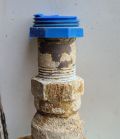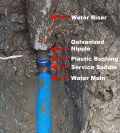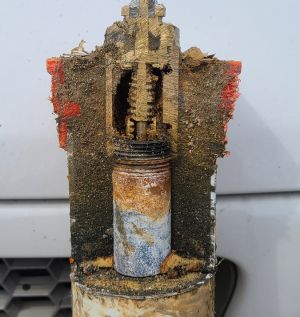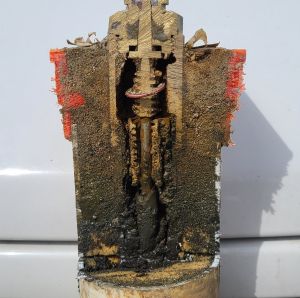Repairing A Water Service
Some genius thought it would be a great idea to put a plastic and copper device under shifty ground, with moving parts, that would deliver water, full of minerals, cholrine, and other caustic chemicals, to a mobile home. This genius went on to design this device and then bury several thousand (perhaps millions) of them into the ground.
Another certified genius decided to put several thousand (perhaps millions) 40,000 pound mobile homes directly on top of this faulty system. This particular genius gave no care to the fact that these homes would be set low to the ground, usually with around 30 inches of clearance, giving almost no access to water services. The fact that they may need to be repaired did not cross their mind. A typical case of Not my problem.
It is because of these ideas, that water services repairs occur almost daily in mobile home parks. Especially when such devices were installed 30, 40, 50, and even 70 years ago.
Water Service
What is a water service? A water service, put simply, is a mechanism designed to bring water into a home. This can be in a mobile home, an apartment, a condominium, or a traditional home. Modern plumbing snakes through a domicile and allows the resident to flush toilets, pour drinking water, take hot showers, and various other day to day activities.
Depending upon the location of the home, a water service can be from a municipal water system, or any number of other delivery systems, such as well pumps.
Causes of Damage

Areas with factors such as frost heave, seismic activity, shifting sands, and extreme temperature changes are not particularly helpful or healthy for devices placed under ground. These factors tend to push, pull, tug, twist, and lift such devices. Over time, even the strongest of materials will break, especially if they are subjected to extreme cold.
Additionally, home water service involves water.[1] Treated water and pumped well water contain several chemicals which are corrosive or otherwise damaging to the plastics and metals used in delivering water service to a home. Water itself is an oxidizer, causing damage to other substances that it comes in contact with.
In the case of mobile homes, and other homes built in areas that do not have proper drainage, earth settling can also be a factor in damaging a water service. As a home and it's support age, they tend to settle downward. This settling can crush or force a water service down, upward, or twist the service, causing damage and leaks. The materials designed for water service are often not equipped to handle such forces and will fail.
Some water service mechanisms have built in weak spots designed to fail under certain circumstances. These "break points" are meant to be a cheap, easy to change parts that break first rather than damaging the whole unit. They also serve as a early warning system for those meant to fix the service. Unfortunately, they are under several feet of soil and often this warning system is ignored.
Designed to Fail
The whole system is not a permanent one. As with most industrial projects, it is designed to be "maintained" and repaired when water or earth happen to damage it. This is why initial installation and subsequent repairs are often laughed at, scorned, or outright 'hated by the people who maintain water delivery systems. They feel as if they are repairing stupid mistakes done in haste by previous idiots.
Since water freezes at 32 degrees Fahrenheit, all parts of the water service that are above the region's frost line must be protected from cold weather. Portions of the water service below the frost line will not freeze.
Potential reasons why a water service will freeze:
- Insufficient insulation on the water line.
- Total lack of insulation on the water line.
- No Heat Tape.
- Broken Heat Tape.
- Heat Tape not plugged in.
- Skirting around home is broken, missing, or improperly installed.
Discovery
Discovery of damaged water systems can be extraordinarily tricky at times. Under normal circumstances, a damaged water main will expel water at a quick rate, causing ponding and streaming of water on the surface at the site of damage. Older systems may not exhibit obvious damage. Existing infrastructure can make discovery a complicated process when finding leaks.
Extenuating circumstances can hide a water leak from a maintainer, requiring extensive investigation that go above and beyond the normal inspection process. Factors that will obscure normal inspection may include:
- Water leaks near a storm sewer, infiltrating the storm sewer system.
- Water leaks near a sanitary sewer, infiltrating the sanitary system.
- Slow water leaks, characterized by dripping or mild sprays of water, due to underground damage of water main systems, creating voids surrounding the service, but not powerful enough to send water to the surface.
- Water itself, evaporating at ground surface level.
Water Riser
Mobile homes typically have their water lines connected to the water mains under the home. This connection is made with what is called a water riser. Water risers usually consist of
- A male threaded fitting that screws into the service saddle on the water main. This threaded tip is usually made of galvanized steel, but some are made of brass.
- A four foot tube that encases a water pipe. This pipe is usually made of galvanized steel, but can be made of brass. The whole tube is filled with water-proof foam insulation and capped off at the top with a "heat rod."
- The riser top is usually made of plastic and contains a shut of valve that will stop the flow of water within the riser. Additionally, the riser top will have a port that allows for the installation of a heat rod.
- The heat rod is an electrical device that plugs into the home. Once energized, the rod will heat the interior of the water riser.
While the idea of a water riser seems brilliant, actual use has proven otherwise. Metals and plastics around water do not survive long and with constant shifting of the earth, these devices often fail. Furthermore, user error, minerals, and weather conditions can compound problems that occur.
Cutaway of the interior of a water riser top. Chemical reaction with water has caused the insulation to be damaged. This lead to the galvanized steel to rust and then break at a seam.
Removing the galvanized pipe shows the damage to the interior of the pipe and shut off valve, rendering this water riser useless.
The Fix
Once a water leak is detected, it must be diagnosed as to what is wrong with the service. If a water leak is on the surface, this may mean that fixtures need to be replaced. However, if a water leak is found to be underground, the riser will have to be dug out and inspected where it connects to the water main. This inspection can only be done by digging down to the main itself; usually around six feet down.
Once digging to the water main connection is done, proper work space must be made for the use of tools. This means that an area must be dug out around and under the point where the riser and main connect so that pipe wrenches can be fully swung.
At this time, the cause of the leak can be determined and usually leads to the complete removal of the water riser. Once the riser is removed from the area, a new standpipe can be installed. This standpipe is usually PEX, which is cross-linked polyethylene pipe that is designed to withstand water better than the galvanized steel found in water risers.
Now that the PEX is installed in the main, the home can be reconnected to the water service and the whole can be backfilled.
References
- ↑ Really bad stuff.
SharkBite | Plugging A Tire | Do It Yourself! | Frost Heave | Terramite T5C | Shit, Shower, Shave | A Stick | Analog Water Meter | Testing A Drinking Water System | Husqyvarny | Putting A Tire On A Rim | Repairing A Water Service | A Pocketknife | Valve Snake | Bobcat and Bush Hog | Andre | Mr. Mitchell | DIY - Coffin | ZERK | Installing A Shut Off Valve On A Water Main | Stupid Baby Bunny | Putting In A Curb Stop | What To Do With An Old Mobile Home | Shed Happens | Skid Donuts | The Greatest NFL Team Of All Time | So, Your Hydraulic Pump Died On Your Dump Bed? | Sully | Penis Bone | Jump Start Your Truck With A Cordless Battery | Audrey Elizabeth Hale | Notre Dame | 710 | Green Leaf Volatiles | Perfect | Cyrus Nock | HVAC | Labor Day Weekend | Alone | Cedar | One Tough House | Heat Tape | John Cena | Mother's Day | Sweeping T | PVC Slide Repair Coupling | Stealing Water | Mini Excavator | Hockey | Putting A Mobile Home On It's Runners | Barron Trump | Jack Tatum





